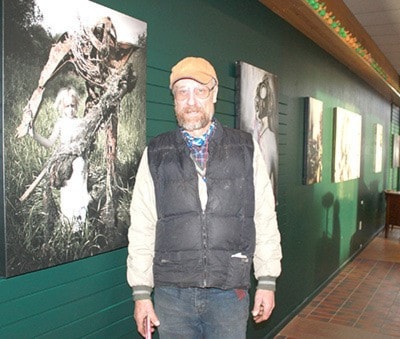Most folks who have known South Cariboo rancher Gus Horn for long will be well aware of his avid support for both art and the environment in his community.
Now, he is opening a pop-up gallery at 2-150 Birch Ave. (formerly Hemingway's) on Nov. 25 until after Christmas.
It features the art of Karl Mattson of Rolla, near Dawson Creek, who is concerned about the
fate of its pristine farmland – mostly due to an abundance of shale gas in the area.
Gus explains that Mattson knows this gas can be extracted by many means, including fracking.
The environmental concerns in Mattson's community are featured in a seven-minute video that can be watched from outside through a gallery window, he adds.
The Critical Mass gallery will have a public opening at 7 p.m. on Friday (Nov. 25).
Gus says it will then be open for regular hours beginning Nov. 30, Wednesdays through Saturdays, 10 a.m.-5 p.m.
Folks interested in private showings, or the film nights he also shows by invitation, can text their request to him at 250-644-0228,or e-mail criticalmass1922@gmail.com.
Gus says most of the mixed media art display at Critical Mass is photography painted over with various mediums.
The first display is Mattson's Hinterland collection, but it will be "an evolving and revolving show," Gus explains.
There is also one of Mattson's highly-unique Life Pods set up in the middle of the gallery. It's made of reclaimed metals welded into a pseudo-coffin with an oxygen tank, tight seals and inside latches, intended to protect the occupant from dangerous gases for several hours.
"His issue isn't with industrialization per se, as in the inadequate emergency warning and response system – that the oil and gas companies don't have – to warn him [and his family], who are there living in the middle of "frack-land."
Gus explains it is important to him on both a personal and a political level to help the artist raise awareness of this message.
"How much of [the art] I expect to sell – how commercial it is – is secondary, of course. My politics are more important than paying the rent."
The local cattle rancher and hay farmer says he has seen firsthand the impacts of industrialization on agriculture, in particular, mostly in his travels through the Fort St. John area.
"When I was on the Agriculture Land Commission, Rolla was said to have some of the finest soil in the Peace River area."
(He was a commissioner and vice-chair of Panel B covering British Columbia's Lower Mainland and North in 2001/02).
However, he adds many Northern B.C. farmers are "the first to say they don't mind having the cheque for the leases for the surface rights," whether it's for an access road or a drilling site to help their business survive.
Noting "we are all addicted" to burning gas and diesel and, therefore, are also "part of the problem," he says the costs of industrialization is often borne by the people who benefit the least.
Gus adds the skill involved in Mattson's artwork as demonstrated through mixed media on display is "remarkable," and he encourages everyone to turn out for the public opening or drop by during its regular hours to experience it for themselves.
